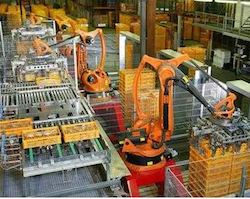Microsoft, Nokia Partner on Factory Floor

The framework for the next industrial phase dubbed Industry 4.0 is taking shape as cloud and networking vendors join forces to accelerate automation on the factory floor.
The latest partnership includes Microsoft (NASDAQ: MSFT) and Nokia (NYSE: NOK), its former mobile phone unit turned infrastructure vendor. The partnership combines Nokia’s 5G network equipment with on-premise Azure cloud components aimed at connecting industrial automation applications.
The automation initiative incorporates Nokia’s software-defined wide-area network (SD-WAN) with the Azure cloud’s virtual WAN. Together, they will be used to automate WAN connectivity with the goal easing and accelerating access to cloud applications between connectivity hubs.
BT, the British telecommunications vendor, is the first customer for industrial automation platform, Microsoft and Nokia said Tuesday (Nov. 5). London-based BT (OTCMKTS: BTGOF) will offer a managed service to industrial users combining Nokia’s SD-WAN 2.0 platform with the Azure cloud.
Microsoft acquired the former mobile phone market leader in 2013 as part of an ambitious plan to manufacture cellphones based on Microsoft software. In 2016, Microsoft sold the brand to a startup launched by a former Nokia executive.
Nokia has since shifted its emphasis to networking gear for Internet of Things and industrial automation applications that are supported by cloud platforms like Azure. Those 5G-based connectivity efforts seek to provide industrial users with secure connections and greater network bandwidth than traditional Wi-Fi networks.
The partnership also calls for hosting Nokia’s analytics, virtualization and automation platform on Azure. The AI tools would allow service providers to move from private datacenters to the Azure cloud while gaining access to Nokia’s 5G network capabilities.
The partners said the industrial IoT platform could be used, for example, to connect smart tools and machines on the factory floor to boost productivity or make manufacturing workflows more flexible.
Autonomous vehicles and robots could also be incorporated in industrial settings to advance automation, efficiency and worker safety.
“Bringing together Microsoft’s expertise in intelligent cloud solutions and Nokia’s strength in building business and mission-critical networks will unlock new connectivity and automation scenarios,” said Jason Zander, executive vice president of Microsoft Azure.
While the Microsoft-Nokia partnership focuses on IoT infrastructure, a growing list of vendors including Microsoft are looking to combine AI tools with industrial IoT deployments. Many IoT initiatives are using some form of AI as operators leverage automation to keep pace with huge data volumes and high data frequency generated by connected devices.
A recent vendor survey found that 90 percent of “AIoT” adopters found the combination had exceeded expectations in terms of indicators like operating costs and employee productivity. Industrial IoT projects are among the earliest adopters of AIoT technologies, the survey revealed.
Related
George Leopold has written about science and technology for more than 30 years, focusing on electronics and aerospace technology. He previously served as executive editor of Electronic Engineering Times. Leopold is the author of "Calculated Risk: The Supersonic Life and Times of Gus Grissom" (Purdue University Press, 2016).










